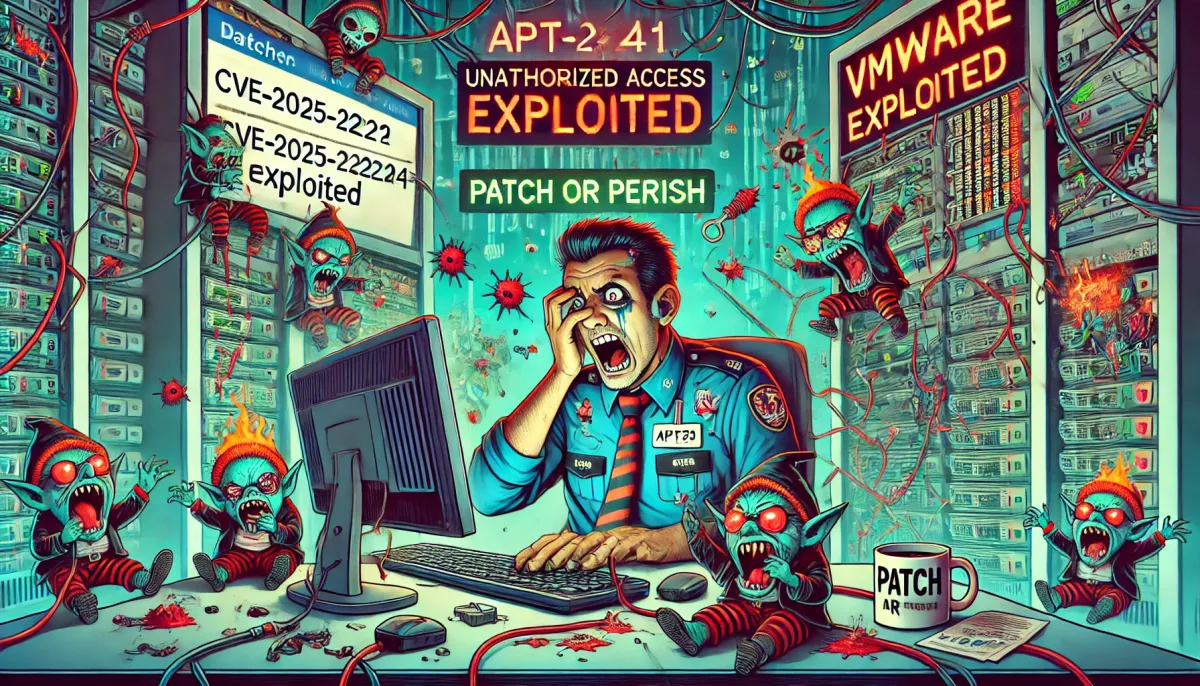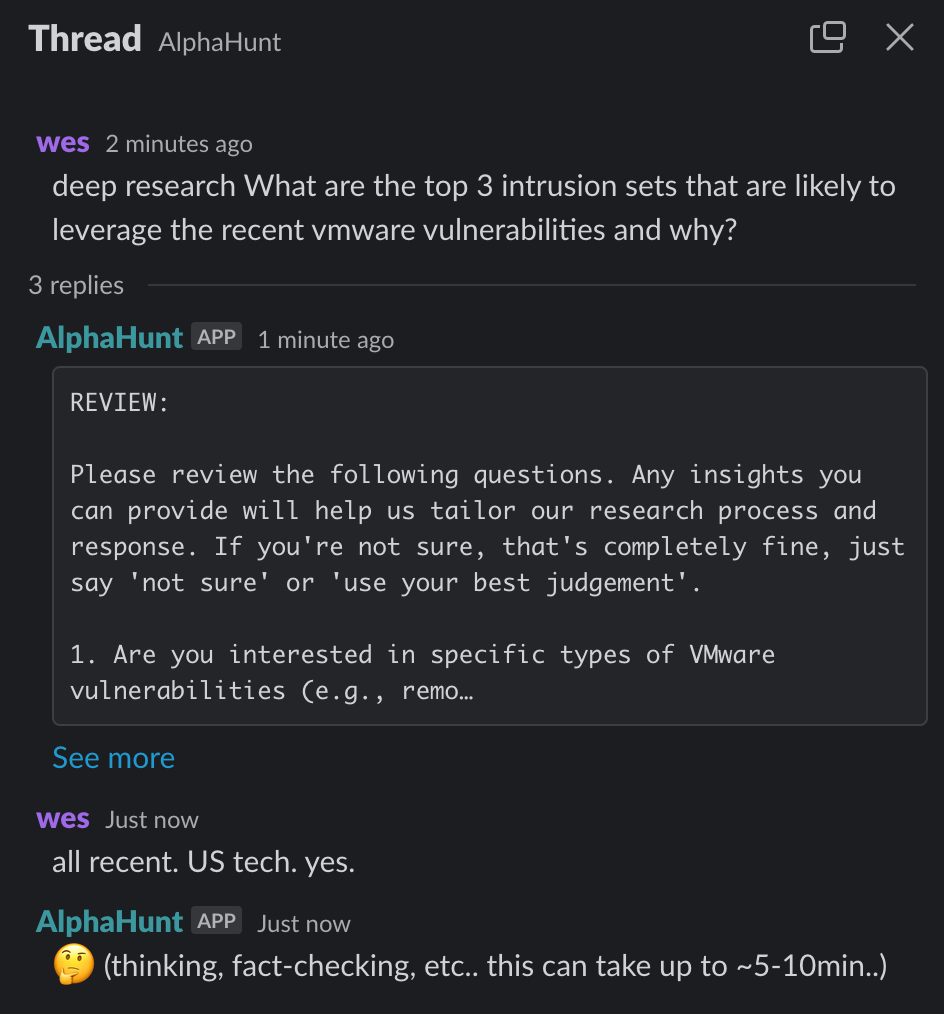VMware Vulnerabilities: APT29, APT41, and APT28's Exploitation Tactics
Recent analysis highlights the potential exploitation of VMware vulnerabilities (CVE-2025-22224, CVE-2025-22225, and CVE-2025-22226) by APT29, APT41, and APT28. These groups are known for...


EDITOR'S NOTE: I'm testing the next generation of the AlphaHunt- the research goes a bit deeper, a bit more directed and a bit more "peer" reviewed. The layout may still need some work... feedback welcome (just hit reply! :))
TL;DR
Key Points
-
- APT29, APT41, and APT28 are likely to exploit VMware vulnerabilities CVE-2025-22224, CVE-2025-22225, and CVE-2025-22226.
- Organizations should prioritize immediate patching to mitigate risks.
-
- These APT groups have a history of targeting virtualization technologies for espionage and financial gain.
- Implement enhanced network segmentation and deploy intrusion detection systems to limit potential breaches.
-
- The exploitation of these vulnerabilities could lead to significant data breaches and service disruptions, especially in sectors like finance and healthcare.
- Utilize threat intelligence platforms and update incident response plans to improve preparedness.
Summary
Recent analysis highlights the potential exploitation of VMware vulnerabilities (CVE-2025-22224, CVE-2025-22225, and CVE-2025-22226) by APT29, APT41, and APT28. These groups are known for targeting virtualization technologies, with motivations ranging from state-sponsored espionage to financial gain. Their tactics include spear-phishing, custom malware deployment, and exploiting vulnerabilities for privilege escalation.
APT29, also known as Cozy Bear, has previously targeted VMware products, using techniques like spear-phishing and backdoor installations to maintain access. APT41, with dual motivations, exploits enterprise software vulnerabilities for both espionage and financial gain, often employing ransomware tactics. APT28, or Fancy Bear, focuses on government and military sectors, using similar methods to gain unauthorized access.
Organizations are advised to immediately patch these vulnerabilities, implement network segmentation, and deploy intrusion detection systems like Snort or Suricata. Utilizing threat intelligence platforms such as Recorded Future or Mandiant can provide timely insights into emerging threats. Additionally, updating incident response frameworks, like NIST SP 800-61, is crucial for preparedness.
The exploitation of these vulnerabilities poses significant risks, particularly to financial institutions and healthcare providers, where breaches could lead to unauthorized access to sensitive data and operational disruptions. The forecast suggests an increase in targeted ransomware attacks and evolving APT tactics over the next 12-24 months, necessitating ongoing vigilance and adaptation of security measures.
Research
Based on the analysis of the recent VMware vulnerabilities (CVE-2025-22224, CVE-2025-22225, and CVE-2025-22226), the following intrusion sets are identified as likely to exploit these vulnerabilities, along
with a deeper analysis of their Tactics, Techniques, and Procedures (TTPs):
1. APT29 (Cozy Bear)
- Historical Activities: APT29 has a history of targeting virtualization technologies to gain footholds in networks. They previously exploited vulnerabilities in VMware products, such as CVE-2020-3956,
which allowed them to escape virtual machine environments. - TTPs:
- Initial Access: Spear-phishing emails with malicious attachments or links.
- Execution: Use of custom malware (e.g., "Dukes" malware) to execute commands on compromised systems.
- Persistence: Installation of backdoors to maintain access, often using legitimate software to blend in.
- Privilege Escalation: Exploiting vulnerabilities to gain higher privileges within the network.
- Data Exfiltration: Utilizing encrypted channels to exfiltrate sensitive data.
- Motivations: Primarily state-sponsored espionage, focusing on government and critical infrastructure sectors. Their interest in VMware vulnerabilities stems from the potential to access sensitive
environments and data.
2. APT41
- Historical Activities: APT41 has been known to exploit vulnerabilities in enterprise software, including virtualization platforms, for both financial gain and espionage. They have previously targeted
VMware vulnerabilities like CVE-2019-5544. - TTPs:
- Initial Access: Exploiting vulnerabilities in web applications and using social engineering tactics.
- Execution: Deployment of malware such as "ShadowPad" for remote access.
- Persistence: Use of legitimate software and services to maintain access.
- Privilege Escalation: Leveraging known vulnerabilities to escalate privileges.
- Impact: Conducting ransomware attacks and data theft for financial gain.
- Motivations: APT41's dual motivations of espionage and financial gain make them particularly interested in high-impact vulnerabilities like those in VMware products, which can be exploited for both
purposes.
3. APT28 (Fancy Bear)
- Historical Activities: APT28 is known for targeting vulnerabilities in virtualization technologies, particularly for privilege escalation and arbitrary code execution. They have a history of exploiting
similar vulnerabilities to gain unauthorized access to sensitive systems. - TTPs:
- Initial Access: Spear-phishing campaigns targeting high-profile individuals and organizations.
- Execution: Use of malware such as "Sofacy" to execute commands on compromised systems.
- Persistence: Establishing footholds through backdoors and legitimate software.
- Privilege Escalation: Exploiting software vulnerabilities to gain elevated privileges.
- Data Exfiltration: Utilizing various methods to exfiltrate sensitive information, often targeting government and military sectors.
- Motivations: APT28's focus on government and military sectors aligns with their interest in VMware vulnerabilities, as these can provide access to critical systems and sensitive information.
Insights into Targeting VMware Vulnerabilities
- Previous Targeting Patterns: All three groups have a history of exploiting vulnerabilities in virtualization technologies, indicating a strategic focus on environments where VMware products are prevalent.
- Geographic Focus: These groups primarily operate from Russia and China, targeting organizations in the U.S. and allied nations, particularly in government, defense, and technology sectors.
- Potential Impact: The exploitation of these vulnerabilities can lead to significant data breaches, unauthorized access to sensitive information, and disruption of services, particularly in sectors heavily
reliant on VMware products.
Recommendations for Organizations
- Mitigation Strategies: Organizations using VMware products should prioritize patching these vulnerabilities, implement network segmentation, and enhance monitoring for unusual activities.
- Specific Tools and Frameworks:
- Intrusion Detection Systems: Consider deploying tools like Snort or Suricata for real-time monitoring.
- Threat Intelligence Platforms: Utilize platforms such as Recorded Future or Mandiant for ongoing threat analysis and intelligence sharing.
- Incident Response Frameworks: Adopt frameworks like NIST SP 800-61 for incident response planning and execution.
References
- (2025-03-04) CVE-2025-22224 Detail - NVD
- (2025-03-04) CVE-2025-22225 Detail - NVD
- (2025-03-04) CVE-2025-22226 Detail - NVD
- (2025-03-04) VMware Security Alert: Active Exploitation of Zero-Day Vulnerabilities
- (2025-03-04) Broadcom Patches 3 VMware Zero-Days Exploited in the Wild
Recommendations, Actions, Suggested Pivots, Forecasts and Next Steps..
(Subscribers Only)


![[DEEP RESEARCH] Zero-Days Are a Distraction: 2025’s Biggest Losses Were Stolen Tokens + OAuth](/content/images/size/w600/2025/12/zz-3.png)


